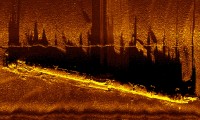 Windfarm developers scanning the southern North Sea floor off the coast of Norfolk for future offshore windfarm projects have discovered the remains of an uncharted German U-boat missing in action since 1915. ScottishPower Renewables (SPR) and Vattenfall scanned the seabed with advanced sonar technology for two years. They covered more than 6,000 square kilometers (2,317 square miles) and discovered more than 60 wrecks in the process, most of them were known. The submarine came as a surprise.
Windfarm developers scanning the southern North Sea floor off the coast of Norfolk for future offshore windfarm projects have discovered the remains of an uncharted German U-boat missing in action since 1915. ScottishPower Renewables (SPR) and Vattenfall scanned the seabed with advanced sonar technology for two years. They covered more than 6,000 square kilometers (2,317 square miles) and discovered more than 60 wrecks in the process, most of them were known. The submarine came as a surprise.
When it was first discovered at a depth of 98 feet about 55 miles east of the Norfolk coast, experts couldn’t be sure which wreck it was. The find was reported to the Receiver of Wreck in the UK, but the scanning company, Dutch contractors Fugro, suggested they contact the Royal Netherlands Navy in case the wreck was of a Dutch submarine from World War II the Dutch Navy has been looking for: military submarine HNLMS O13, last seen in June 1940 while on a mission to patrol the sea between Denmark and Norway. It is The Netherlands’ last unaccounted for missing World War II submarine.
A team of Dutch Navy divers explored the wreck and filmed it in the hopes of getting enough information to conclusively identify the submarine. They found the wreck was 57.6 meters (189 feet) long, 4.1 meters (13.5 feet) wide and 4.6 meters (15 feet) high. Some damage at the bow and stern may have trimmed off some length. Debris found around the wreck suggests it was originally more than 60 meters (197 feet) long. The footage of the submarine captured the conning tower and deck which marked it as a German vessel.  Researchers were able to match it to the Type U-31 German World War I U-boat, the first in a series of eleven sequentially numbered submarines built between 1912 and 1915. Only U-31 and U-34 were known to have been in the area before their disappearance.
Researchers were able to match it to the Type U-31 German World War I U-boat, the first in a series of eleven sequentially numbered submarines built between 1912 and 1915. Only U-31 and U-34 were known to have been in the area before their disappearance.
The wreck was found in September of 2012. It has taken more than three years to finally identify it as U-31.
Mark Dunkley, marine archaeologist at Historic England adds: “SM U-31 was commissioned into the Imperial German Navy in September 1914. On 13th January 1915, the U-31 slipped its mooring and sailed north-west from Wilhelmshaven for a routine patrol and disappeared. It is thought that U-31 had struck a mine off England’s east coast and sank with the loss of its entire complement of 4 officers, 31 men.” […]
“The discovery and identification of SM U-31 by ScottishPower Renewables and Vattenfall, lying some 91km east of Caister-on-Sea, Norfolk, is a significant achievement. After being on the seabed for over a century, the submarine appears to be in a remarkable condition with the conning tower present and the bows partially buried.
“Relatives and descendants of those lost in the U-31 may now take some comfort in knowing the final resting place of the crew and the discovery serves as a poignant reminder of all those lost at sea, on land and in the air during the First World War.”
Because it is an official military maritime grave, the wreck will not be excavated or disturbed. Any future windfarms built in the area will be done without interference with the grave site.
Here’s some wonderful raw footage of the dive by Lamlash North Sea Diving. It’s some of the best underwater exploration footage I’ve seen. You get to see the divers at work in the environment, the light adjustments, the changes in visibility; it’s not just still-worthy shots of the U-boat spliced together. Also the crabs rule there now. That blue crab at the end is clearly claiming the vessel as his own.
[youtube=https://youtu.be/5lT3CZs7u9o&w=430]